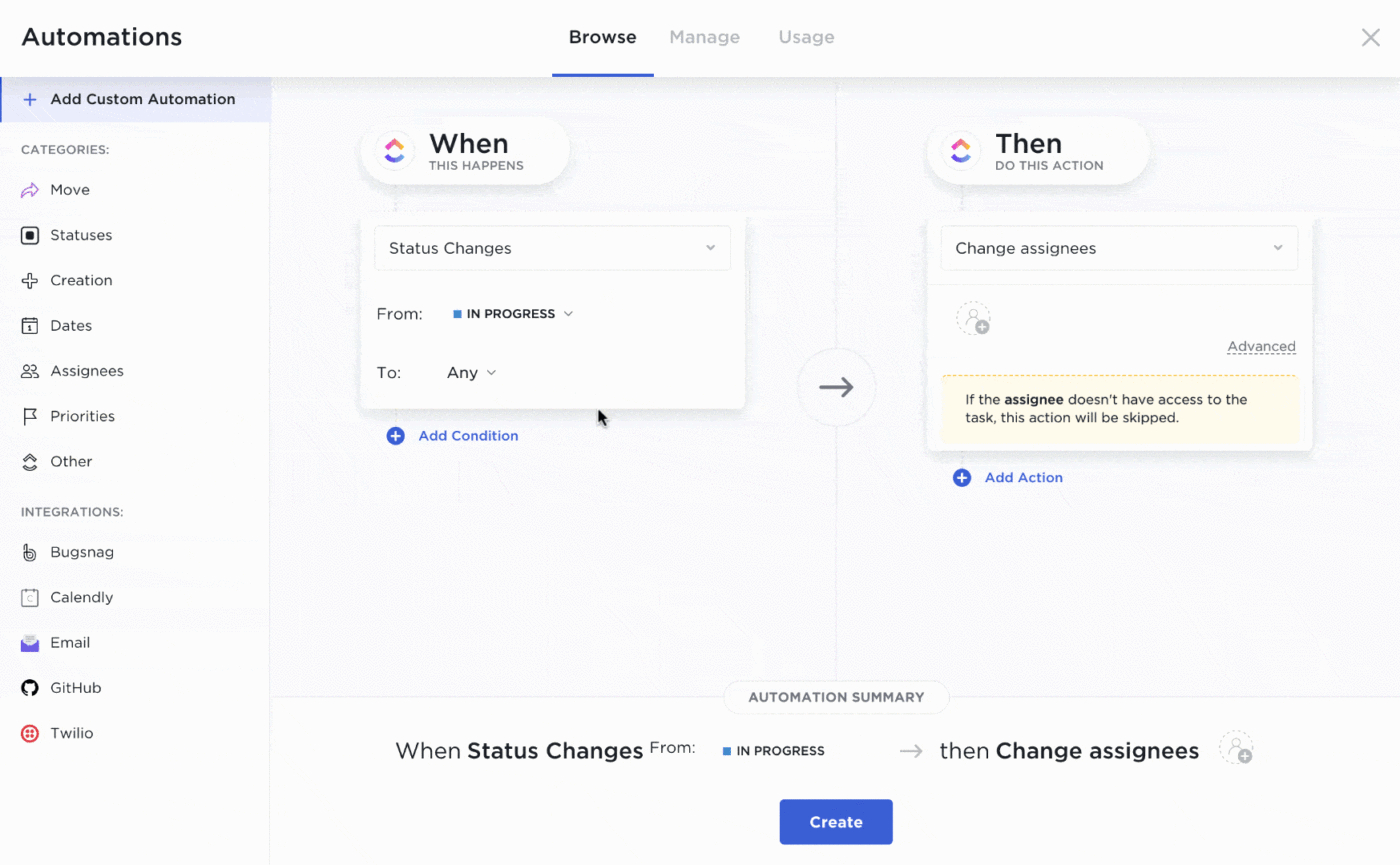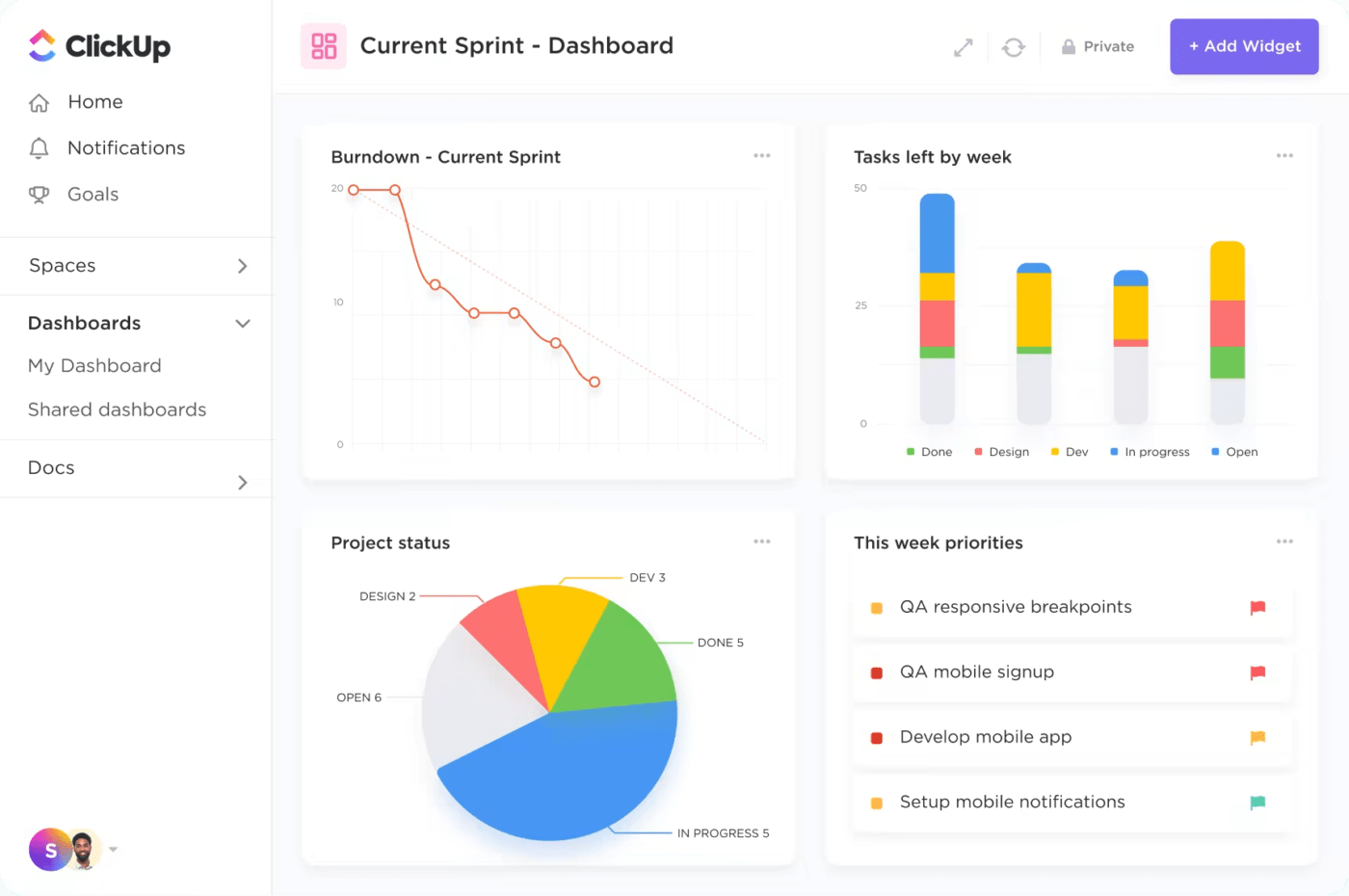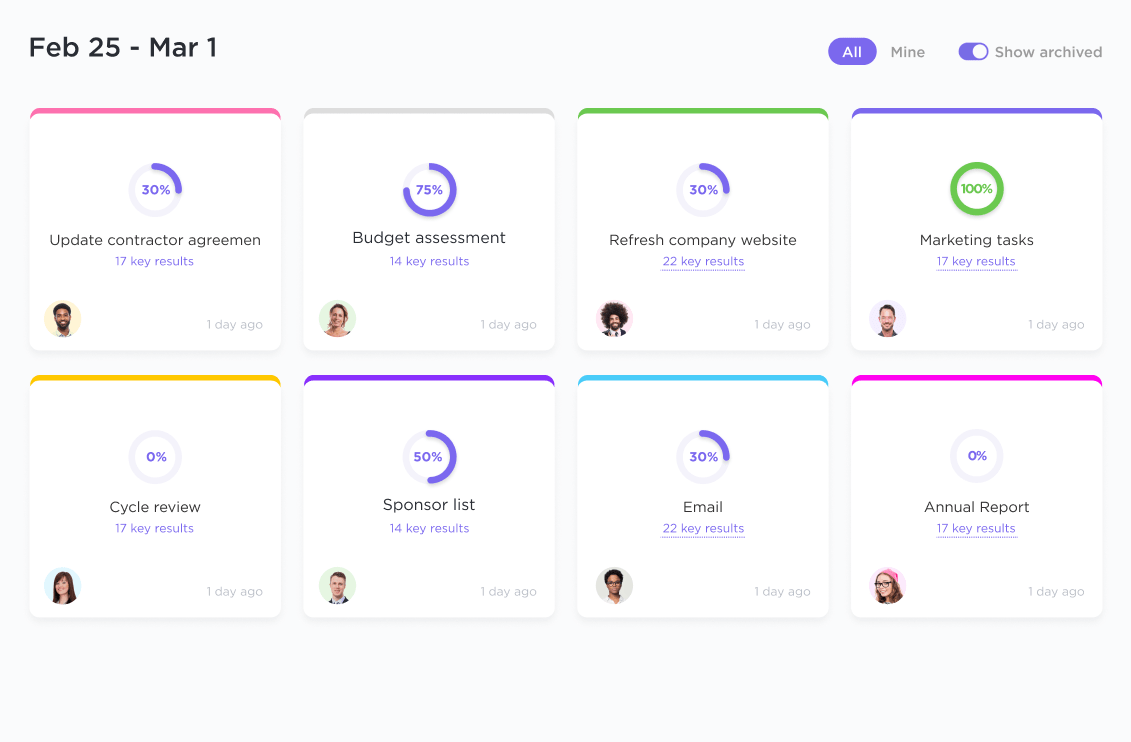سواء كنت تمتلك شركة صغيرة أو كنت مدير مشروع في شركة مؤسسة، فإن العلاقات المتينة مع العملاء أمر لا بد منه. لكن بناء أي علاقة والحفاظ عليها ليس بالأمر السهل، خاصة عندما يتعلق الأمر بإنشاء علاقات قوية مع العملاء على نطاق واسع.
فكلما أضفت المزيد من العملاء إلى قائمتك، يصبح من الصعب تلبية التوقعات والتواصل بفعالية وإقامة روابط دائمة مع عملائك المفضلين.
ولكن مع استراتيجيات إدارة العملاء الصحيحة، لن تقوم ببناء علاقات جيدة مع عملائك فحسب، بل ستتمكن أيضًا من تبسيط سير عملك وتعزيز الربحية. ما الذي لا يعجبك؟ 😍
سنشرح في هذا الدليل أساسيات إدارة العملاء، وسبب أهميتها، ونصائح قابلة للتنفيذ لتعزيز مهاراتك في إدارة العملاء.
ما هي إدارة العملاء؟
إدارة العملاء هي عملية تكوين علاقات قوية مع العملاء الحاليين والمحتملين والحفاظ عليها بشكل استراتيجي. والهدف من ذلك هو معرفة المزيد عن عملائك الحاليين والمحتملين، وتوقع احتياجاتهم، وتقديم خدمة ممتازة في كل نقطة اتصال. ✨
من الواضح أن معاملة العملاء بشكل جيد هي من أفضل الممارسات التجارية - إدارة العملاء تقنن هذه الممارسة وتوفر بنية مفيدة لإدارة العلاقات مع العملاء.
للنجاح في إدارة العملاء، ابدأ باتباع هذه الإرشادات:
- سجل بيانات العميل في إدارة علاقات العملاء(CRM) منصة إدارة علاقات العملاء مثلسيلز فورس أوانقر فوق
- تعيين مديري العملاء لسد الفجوة بين الشركة والعميل
- إعدادمشاركة المستندات مع العملاء
- إنشاء جدول زمني منتظم لعمليات التحقق من العملاء، ويفضل أن يتم ذلك قبل حدوث أي مشكلة
- بشكل استباقيالتماس الملاحظات من العملاء الحاليين
- التركيز علىالاحتفاظ بالعملاء مع عمليات البيع والبيع التبادلي
في نهاية المطاف، فإن الشركات التي تستثمر في تعزيز العلاقات طويلة الأمد مع العملاء ستعزز ربحيتها.
ما أهمية سير عمل إدارة العملاء؟
في بعض الأحيان إدارة توقعات العملاء وجهات الاتصال قد تبدو وكأنها مهمة لا تنتهي أبدًا. فأنت تريد أن تكون مزود الخدمة المفضل، ولكن عندما يكون لديك 15 عميلاً يتحدثون معك في وقت واحد، فمن الصعب أن تعد بأقل مما يجب وتفي بأكثر مما يجب.

تتبع الحالات وتواريخ الإغلاق والاستحقاق والميزانيات وأحجام الحسابات والمزيد بسهولة في إدارة علاقات العملاء القابلة للتخصيص في ClickUp
والخبر السار هو أنه مع وجود نظام رائع لإدارة العملاء ومدير عملاء مطلع، يمكنك تبسيط عملك وبناء علاقات جيدة مع العملاء في نفس الوقت. ليس من الضروري أن تكون إدارة جميع عملائك كابوساً مزعجاً وأن تفرط في تقديم قيمة عملك.
على الرغم من وجود العديد من المزالق في إدارة العملاء، إلا أن هناك فوائد رئيسية أخرى أيضاً.
تبني الثقة وتحافظ على رضا العملاء
الثقة هي حجر الزاوية في أي علاقة طويلة الأمد، خاصة في مجال الأعمال التجارية. في الواقع 42% منالمستهلكين سيذهبون إلى منافس إذا توقفوا عن الوثوق بالعلامة التجارية، لذلك لم يكن الأمر أكثر من من المهم للشركات بناء الثقة .
عندما تعزز علاقتك بالعملاء بشكل أفضل، يكون لديك المزيد من الفرص للتواصل مع عملائك وإسعادهم، مما يبني الثقة مع مرور الوقت.
يعزز الاحتفاظ بالعملاء وفرصة الاحتفاظ بالعملاء مدى الحياة
لماذا تتعب نفسك في البحث عن أعمال جديدة بينما يمكنك العمل مع العملاء الرائعين الذين لديك بالفعل؟ تعمل إدارة العملاء على تبسيط سير عملك لتحقيق ولاء العملاء تلقائيًا وعلى نطاق واسع.
يحسن جودة خدمة العملاء لديك
يقدّر العملاء عمليات التحقق الاستباقية والتواصل الواضح. ولكن من الصعب تقديم هذين الأمرين دون وجود استراتيجية قوية لإدارة العملاء.
من خلال النهج الصحيح، يمكنك تقديم خدمة عملاء أفضل لجميع العملاء دون إرهاق فريقك. أنت تحتاج فقط إلى الأدوات والإعدادات الصحيحة. ⚒️
ينمو عملك مع فرق داخلية أكثر ذكاءً
بالتأكيد، معاملة عملائك بشكل جيد هو الشيء الصحيح الذي يجب القيام به، ولكنه يأتي أيضًا بأثر جانبي لطيف: المزيد من الإيرادات.
فالعملاء السعداء يبقون معك لفترة أطول، وينفقون أكثر، بل ويدافعون عن علامتك التجارية. في الواقع، 60% من المتسوقين سيتعاملون معك أكثر إذا كانت تجربتهم جيدة، وهذا أمر رائع بالنسبة لميزانيتك. 💰
وليس هذا فحسب، بل يمكنك بناء فريق أكثر ذكاءً لإدارة رضا العملاء بفعالية، مع السماح لفريقك بجلب عملاء جدد بشكل أفضل.
كيفية إنشاء سير عمل إدارة العملاء
مهارات إدارة العملاء هي المفتاح لرضا العملاء وامتلاء خزائن الشركة. تكمن المشكلة في أن إدارة العملاء ليست دائماً سهلة، خاصةً إذا كان لديك الكثير من العملاء أو إذا كان فريقك يفتقر إلى الأدوات المناسبة لهذه المهمة.
لحسن الحظ، فإن إدارة العملاء أمر سهل مع الاستراتيجية الصحيحة. اتبع هذه النصائح العشر لإدارة العملاء بفعالية.
1. استخدم نظام إدارة علاقات العملاء
قم بإدارة العملاء المحتملين وعلاقات العملاء والمبيعات في مكان واحد باستخدام قالب ClickUp CRM هذا
بمجرد فهمك لعملائك، فقد حان الوقت لتعبئة بيانات عملائك في CRM.
يعد تخزين بيانات العملاء عبر البريد الإلكتروني أو جدول البيانات بداية، لكنه يبطئ فريقك عندما يبحثون عن التفاصيل. بالإضافة إلى ذلك، إذا كان العديد من أعضاء الفريق يتواصلون مع نفس العميل، فمن الصعب توثيق كل نقطة اتصال في جدول بيانات في الوقت الفعلي.
يعد نظام إدارة علاقات العملاء أمرًا ضروريًا لإدارة العملاء. باستخدام CRM، يمكنك الاحتفاظ بسجل لـ
- نقاط بيانات العميل، مثل الاسم والبريد الإلكتروني والشركة
- جميع نقاط اتصال العملاء عبر المكالمات الهاتفية أو البريد الإلكتروني أو حتى وسائل التواصل الاجتماعي
- الإجراءات التي اتخذها فريقك للتواصل مع هؤلاء العملاء
هناك الكثير من خيارات برامج إدارة العملاء للاختيار من بينها، ولكن من الأفضل اختيار خيار يمزج بين وظائف إدارة علاقات العملاء وإدارة المشاريع .
بدلاً من الاحتفاظ بمهامك منفصلة عن بيانات عملائك، يدمج هذا البرنامج بين الاثنين لإدارة جميع العملاء والمهام في مكان واحد يسهل العثور عليه.
2. تعرف على أكبر احتياجات كل عميل
تعاون على الأفكار وأنشئ مستندات أو صفحات ويكي مذهلة مع صفحات متداخلة لمديري العملاء لتسجيل جميع اتصالات العميل وأهم المعلومات
أنت تستهدف شريحة معينة من العملاء، لذلك سيكون لدى جميع عملائك شيء مشترك. ولكن حتى مع ذلك، ستختلف احتياجاتهم. قد يقلق أحد العملاء في الغالب بشأن التكاليف، في حين أن الوقت الضائع والإنتاجية يشغلان بال عميل آخر.
كل عميل لديه حاجة، ومهمتك هي العثور عليها. خلال مكالمتك الأولى مع العميل، تدرب على الاستماع النشط لمعرفة أكبر التحديات التي تواجهه.
اكتشف أكبر مشاكل عميلك بسرعة
لا يتعلق الأمر بعملك أو الترويج لمنتج أو خدمة معينة. بل يتعلق الأمر كله بتحديد التحديات التي تواجه العميل، والتي يجب أن يكون لها تأثير كبير على كيفية إدارتك للعلاقة مع العميل.
على سبيل المثال، إذا كنت B2B SaaS الشركة والتحدي الأكبر الذي يواجهه العميل هو الدقة المحاسبية، يجب أن تعتمد رسائلك بشكل كبير على الموثوقية والثقة والمقاييس القابلة للقياس الكمي.
لا يجب أن تكون هذه عملية مطولة أيضًا. فقط اسأل عملاءك، "ما هو التحدي الأكبر الذي تواجهه؟ " وستحصل على جميع الإجابات التي تحتاجها.
بمجرد أن تعرف أكبر احتياجات العميل، قم بتوثيقها في نظام إدارة علاقات العملاء الخاص بك. وأنشئ حقلاً مخصصاً لنقاط الألم حتى يكون لدى فريق المبيعات لديك المعرفة اللازمة لتقديم مساعدة مخصصة لكل عميل، بغض النظر عن الشخص الذي يتحدث إليه.
3. قم بإنشاء عملية تأهيل العميل

قالب تهيئة الموظف العام من ClickUp
مثل أي علاقة، فإن الانطباعات الأولى مهمة عند العمل مع العملاء. ابدأ العلاقة بشكل صحيح من خلال توجيه العملاء الجدد من خلال عملية تأهيل منظمة. مع عملية تأهيل العميل فإن فريقك
- يرسل استبيانات
- إنشاء اتفاقيات مستوى الخدمة (SLAs)
- جدولة الاجتماعات
- يخطط للمتابعة المنتظمة
تصبح إدارة العميل أسهل بكثير عند توحيد معايير عملية تأهيل العميل . فكر في الأمر على أنه توجيه للعميل الجديد حيث ترحب بالعميل في عملك وتدريبه على كيفية القيام بالأمور.
إن التهيئة هي فرصتك الأولى لتُظهر للعملاء أنهم اتخذوا الخيار الصحيح بالعمل معك، لذا قم بإنشاء تجربة ممتازة تذهلهم. 🧦
4. الأتمتة حيثما أمكن

استخدم وصفات الأتمتة المُنشأة مسبقًا في ClickUp أو قم بتخصيصها بناءً على احتياجاتك، حتى يتمكن فريقك من التركيز على ما هو أكثر أهمية
الإدارة اليدوية للعملاء ممكنة للشركات الصغيرة، ولكن إذا كنت تتحدث مع عشرات العملاء يومياً، فسوف يزدحم صندوق الوارد الخاص بك بسرعة.
طالما أنك تستخدم نظام CRM قوي، يمكنك أتمتة الكثير من مهام إدارة العملاء. على سبيل المثال، يعد تأهيل العملاء المحتملين وإدارة دورة حياة العميل وإعداد العميل مرشحين رئيسيين للأتمتة. أتمتة سير عمل إدارة علاقات العملاء يستخدم خرائط منطق السحب والإفلات "إذا ثم" لتوجيه اتصالات العميل والمهام وحالات المشروع تلقائيًا من خلال CRM دون أي إدخال يدوي من فريقك. جميل، أليس كذلك؟
ولكن إذا كنت تريد أن تأخذ الأمور إلى أبعد من ذلك، فقم بتخصيص نظامك باستخدام قوالب إدارة علاقات العملاء المجانية من ClickUp . وفر الوقت في التنسيق وركز على عملائك مع القوالب. استخدم قالبًا لتتبع العمولة، وخطوط أنابيب المبيعات، وإدارة خدمة العملاء - لا حدود لما يمكنك فعله. 🤩
5. ضع توقعات واضحة

ابحث عن الأرقام الدقيقة على الفور باستخدام صيغ بسيطة أو متقدمة في الحقول المخصصة في ClickUp Custom Fields
وضع الحدود أمر مهم في أي علاقة. عندما يعرف العميل ما يمكن أن يتوقعه منك، فإن ذلك يوفر على الجميع متاعب العمل خارج النطاق والعملاء المحبطين.
قبل أن تقوم بأي عمل، ضع توقعاتك مع العميل من أجل:
- التسعير
- الجداول الزمنية
- مراحل العمل
- خارطة طريق محددة للعمل الذي سيكمله فريقك
- المعلومات أو المواد التي يجب أن يقدمها العميل
- مقاييس النجاح
- عدد المرات التي ستتواصل فيها
- القنوات التي ستستخدمها للتواصل
يجب أن توضح عقود العميل أو اتفاقيات مستوى الخدمة الخاصة بك هذه التوقعات بالأبيض والأسود، ولكن يجب عليك أيضًا تحديد التوقعات أثناء مكالمات إعداد العميل. ومع ذلك، ما زلنا نوصي بتوثيقها كتابياً في مكان ما.
ولكن تذكر أن الحدود لا تعني شيئاً إذا لم تقم بتطبيقها. إذا كان فريقك يواجه صعوبة في قول لا، فقد تحتاج إلى تدريب على إدارة العملاء لتتعلم كيفية رسم خط فاصل (بأدب). 🏖️
6. الاستفادة من البيانات لإعطاء اهتمام شخصي

تتبع ومراقبة المهام والموارد وتقدم المشروع في عرض لوحة معلومات ClickUp Dashboard
الجميع يريد أن يشعر بالتميز. لا يحب العملاء رسائل البريد الإلكتروني العامة أو الرسائل النصية أو التقارير. فهم يريدون محتوى خاص جداً باحتياجاتهم.
أنت تتتبع بالفعل الكثير من بيانات العملاء في نظام إدارة علاقات العملاء لديك، فلماذا لا تقوم بتعبئة هذه البيانات لمنح عملائك تجربة عالمية المستوى؟
استخدم البيانات للتخصيص:
- طلبات التعليقات أو استبيانات العملاء
- توصيات استباقية أثناء عمليات التحقق المنتظمة
- رسائل "فقط لأنك" تحتفل بأعياد ميلاد عملائك أو مناسبات الذكرى السنوية
- خصومات العملاء أو العروض الترويجية
- جدول اجتماعات العملاء
- قنوات التواصل التي تستخدمها لكل عميل
عادةً ما يتطلب هذا المستوى من التخصيص عملاً عملياً من فريقك. ولكن طالما أنك تقوم بأتمتة عملية إدارة العميل باستخدام نظام إدارة علاقات العملاء القوي، فإنك تتمتع بالقدرة على تخصيص تجارب مئات العملاء في وقت واحد.
7. إجراء عمليات متابعة ومراجعة منتظمة

إنشاء نماذج أكثر ذكاءً في ClickUp باستخدام المنطق الشرطي لتبسيط العملية - بغض النظر عن مدى تعقيدها
لن تعتبر شخصًا ما شريكك المهم إذا لم تسمع منه سوى بضع مرات في السنة، أليس كذلك؟
تتطلب إدارة العملاء متابعة منتظمة جداً. قد يبدو من الغريب أن تتواصل معهم عندما لا يكون هناك أي خطأ، ولكن هذا بالضبط هو الوقت الذي يجب أن تتواصل فيه.
أن تكون استباقيًا هي طريقة رائعة لتقديم خدمة عملاء ممتازة، مما يمنح العملاء الدعم الذي يتوقون إليه مع القضاء على المشاكل المحتملة في مهدها في وقت مبكر. حاول أن تبقي العملاء متفاعلين ومسموعين من خلال فرص التعليقات المتكررة. استخدام نماذج ClickUp مع المنطق الشرطي يجعل من السهل عليك وعلى عملائك البقاء على اتصال.
عالميًا, 70% من العملاء ينظرون بشكل أفضل إلى الشركات التي تقدم خدمة عملاء استباقية، لذا تحقق مع عملائك حتى عندما تسير الأمور على ما يرام. أنت لا تحتاج إلى مكالمات هاتفية لمدة ساعة مع عملائك كل أسبوع. استخدم أدوات خدمة العملاء للبقاء على اتصال عبر
- إشعارات التطبيق
- رسائل البريد الإلكتروني
- طلبات الاستطلاع
- تفاعلات وسائل التواصل الاجتماعي
إذا لم يكن لدى فريقك الوقت الكافي للتحقق بانتظام، فاستخدم الأتمتة لإرسال رسائل متابعة سريعة وفق جدول زمني محدد مسبقاً.
8. إنشاء نظام إحالة
تعمل إدارة العملاء على تحسين تجربة العملاء، ومن المرجح أن يصبح العملاء السعداء أكثر عرضة لأن يصبحوا دعاة للعلامة التجارية. عملاؤك يحبونك بالفعل. لماذا لا تحفزهم على مشاركة الحب مع أصدقائهم؟
تُعد الإحالات الشفهية وسيلة قوية للحصول على المزيد من العملاء ذوي الجودة العالية، لكنها لا تأتي بحافز للمُحيل. شجع المزيد من العملاء المحتملين من خلال إنشاء برنامج إحالة رسمي. قدم خصومات مغرية أو كوبونات أو هدايا مجانية للمُحيلين الناجحين وشاهد العملاء المحتملين وهم يتدفقون. 📈
تذكر أن تتبع جميع الإحالات في نظام إدارة علاقات العملاء الخاص بك. وبمرور الوقت، ستخبرك البيانات عن العملاء الذين يعتبرون من أكبر المؤيدين لك.
9. قم بقياس مقاييس عملائك

تتبع أهدافك وصولاً إلى مؤشرات الأداء الرئيسية الأكثر أهمية واحصل تلقائيًا على مشاهدات مفصلة لتقدمك
أن تعتقد أنك تبلي بلاءً حسنًا شيء، ولكن قياس نجاحك بالأرقام شيء آخر تمامًا. تتمحور إدارة العميل حول البيانات، وتحتاج إلى مقاييس قابلة للقياس الكمي لفهم ما إذا كانت استراتيجية إدارة العميل الخاصة بك تؤتي ثمارها بالفعل.
انتهى 44% من الشركات أن خدمة العملاء هي العامل الرئيسي الذي يميزهم. هامش الخطأ ضئيل، لذا إذا كنت لا تتعقب مقاييس عملائك حتى الآن، فهذه إشارة للبدء.
أي نظام لإدارة علاقات العملاء يستحق أن يتتبع مقاييس إدارة العملاء المهمة، مثل:
- متوسط حجم الصفقة
- صافي نقاط المروجين (NPS)
- معدل التخبط
- معدل الاحتفاظ بالعملاء
- القيمة الدائمة للعميل
التعليقات النوعية مهمة أيضًا. قم بتسجيل جميع تعليقات العملاء والردود على الاستبيانات في نظام إدارة علاقات العملاء لديك لعرض المعلومات النوعية إلى جانب الأرقام الثابتة. سيمنحك هذا فكرة أفضل عن مدى نجاحك في إدارة العملاء.
10. احتفل بالفوز
قد يبدو من المحرج أن تحتفل بنجاحاتك، ولكن عندما تعمل بجد، فأنت تستحق أن تتباهى بها قليلاً. عندما تحقق (أو تتجاوز) توقعات العميل، احتفل! 🎉
هذا أمر رائع لمعنويات فريقك الخاص، ولكنه أيضًا يُظهر للعميل أنك سعيد حقًا بنجاحه وتهتم بنتائج أعماله. بالإضافة إلى أنه يمنحهم القليل من الدوبامين الذي يجعلهم متحمسين للحصول على المزيد من النتائج.
احتفل بعملائك من خلال:
- إرسال بطاقة موقعة من كل من يعمل على حسابهم
- إرسال رسم "تهنئة" مخصص للعميل عبر البريد الإلكتروني
- تصور نجاحهم في تقريرك المرحلي التالي
- تحديد موعد للقاء شخصي معهم
- التباهي بإنجازاتهم على وسائل التواصل الاجتماعيعرضهم في دراسة حالة !
بالإضافة إلى ذلك، فإن العديد من مهام إدارة العملاء مهيأة للتشغيل الآلي، لذلك ستحصل على المزيد من نقاط التواصل مع العملاء مقابل جهد يدوي أقل.
5. بناء صورة علامتك التجارية
في مجال الأعمال، السمعة هي كل شيء. لن يحدث ذلك بين عشية وضحاها، ولكن القيام بعمل جيد باستمرار سيبني شركتك كخبير في المجال.
من خلال تلبية (وتجاوز) توقعات العملاء باستمرار، فإنك تبني الثقة مع عملائك الحاليين. الناس يتحدثون، لذا فهي مسألة وقت فقط قبل أن ينتشر الخبر وتتفوق على منافسيك وتبدأ في كسب عملاء جدد. 🏆
لا يضر أن السمعة هي شيء تكتسبه أنت، لذا لا يمكن لمنافسيك تقليد صورة علامتك التجارية.
## تبسيط إدارة علاقات العملاء مع برنامج إدارة علاقات العملاء المتكامل
الأعمال التجارية تتسم بالتنافسية الشديدة هذه الأيام، ولكن نظام إدارة العملاء المتين سيمنحك أفضلية على منافسيك. إن وضع استراتيجية مقصودة، مدعومة بالأدوات المناسبة، يجعل كل شيء سهل المنال.
فبدلاً من التعامل مع العملاء الحاليين أو المحتملين يدويًا، قم بتوصيل بياناتك في نظام ClickUp CRM.
قم بإدارة بيانات العملاء، ومركزة التواصل، ووفر الكثير من الوقت مع أتمتة ClickUp المدمجة. صمم القالب الخاص بك أو انسخ خياراتنا الجاهزة للعقارات وخدمة العملاء والفواتير وغير ذلك الكثير. قم بإنشاء ClickUp CRM الخاص بك الآن -إنه مجاني إلى الأبد، ولا يتطلب بطاقة ائتمان!


